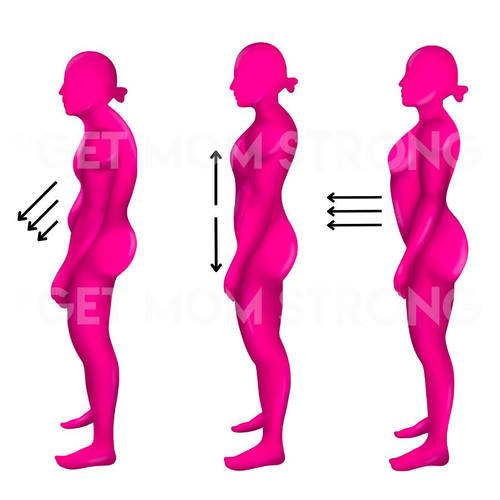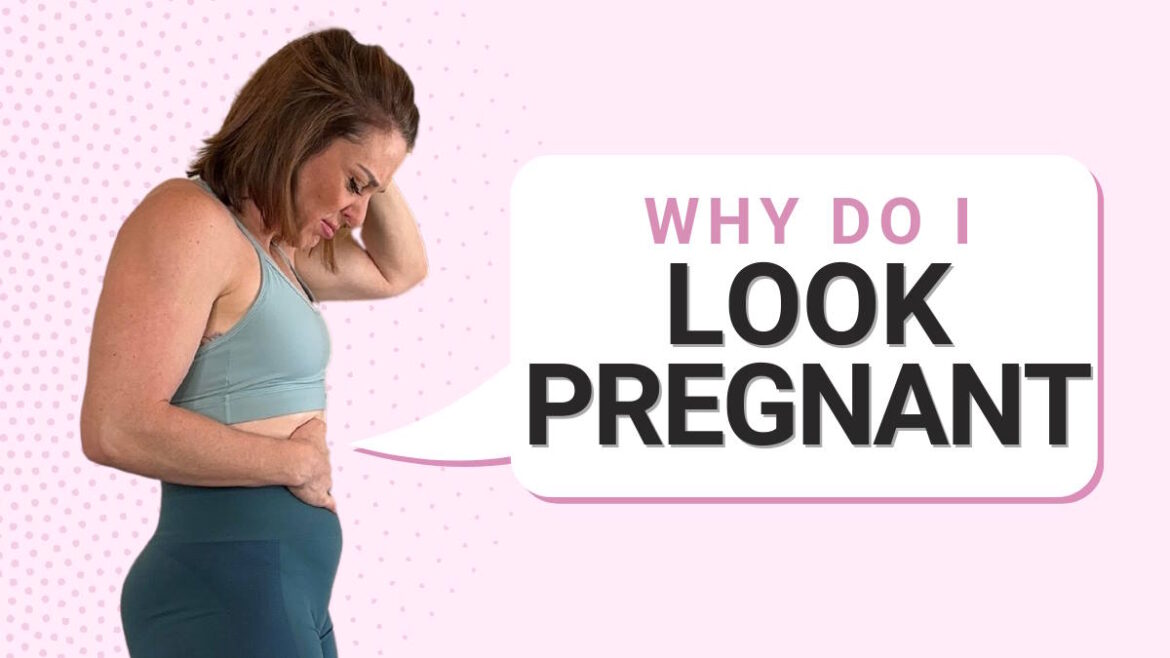Normal bodies take time to heal postpartum. But if you had a baby a while ago and still “look pregnant,” there could be an underlying reason.
Before we dive in, a friendly reminder that many women have some extra fat to protect organs, so please be kind to yourself.
Why Do I Still Look Pregnant?
One of the most common reasons to still appear pregnant months or even years after having a baby is diastasis recti. Diastasis recti is a thinning of the linea alba – the connective tissue that runs between your rectus abdominis, or six pack muscles.
During pregnancy, this tissue thins and widens because of the growing baby. After baby arrives, this connective tissue doesn’t always snap back. Think of this connective tissue like an over-stretched hair tie that has lost some elasticity.
This thinned connective tissue and weakened deep abdominal system, the transverse abdominis, make it so your internal organs aren’t held in quite as tight. This abdominal separation can leave your stomach looking months pregnant even years after delivery.
Many postpartum women have an abdominal separation. It is easy to check yourself for diastasis recti.
The good news is, you can “close the gap” with diastasis recti-specific exercises. SLAM workouts are packed with these core exercises.
No Diastasis Recti… but Still Look Pregnant?
You’ve checked, and your linea alba feels shallow and taut–less than a two-finger width gap. This means there is good integrity of the connective tissue, and you don’t have a significant separation in your abdominal muscles. Yet you still feel or see a “baby bump” and you know you’re not pregnant. What else could be causing it?
Pressure Imbalance/Pressure Management Issue
Your core is a pressure system, and how you breathe affects both your core and pelvic floor.
As you breathe in your diaphragm flattens, gently pushing air down into the lungs. Your pelvic floor relaxes. As you exhale, the diaphragm recoils and the pelvic floor gently lifts.

If you have a belly pooch, you may find yourself sucking in your tummy and gripping your abs to try and hide it. This puts a kink into your pressure system – essentially, you’re breathing backwards, up into your chest.
Think of your core like a balloon. Sucking in at the belly button is much like pressing into the middle of a blown up balloon. The air gets displaced. Your core works the same way. Core pressure must go somewhere, so it gets redistributed. The result? A vicious cycle and a mummy tummy!
If this sounds like you, postpartum exercises focused on healing diastasis recti will also help you learn to manage intra-abdominal pressure.
Poor Posture
During pregnancy your center of gravity shifted, and you may have lost touch your core. Everything is out of whack. And then you’re carrying kids (and all their stuff), hunched over while feeding a baby, or generally trying to compensate for weaknesses. It’s easy to fall into poor posture habits postpartum.
These postural compensations can have a direct impact on the appearance and function of our tummy.

Look at how you stand. Check from the side – do you arch your back and stick your butt out with a anterior pelvic tilt (aka twerker style)? Or do you have a posterior tilt, where you tuck and grip your booty muscles – pushing out your belly?
The goal is… neither of these. You want to align your pelvis and rib cage with a neutral spine. This automatically pulls in your belly.
Extra Adipose Tissue
Female bodies tend to store excess fat in the abdominal area. This is especially common during breastfeeding because bodies need to hang on to extra calories to produce milk. There’s no trick or tip to spot reduce lower belly fat, it’s how we were designed.
Also, we are proud owners of a uterus, which can also make our low tummy a little more pronounced, especially before menstruation.
Eating nourishing foods, moving your body when you can, and getting sleep (if possible) can help our bodies feel better.
Loose Skin
Loose skin tends to hang in the lower portion of our belly, especially if you’ve had a C-section. No matter how much core strength you have, there isn’t much you can do to get rid of loose skin, unfortunately.
Remind yourself that your body created life and that is pretty epic.
If you had a c-section, scar massage can help the appearance of the skin.
Bloating, Digestive Issues, or “Endo Belly”
Ah, bloating. That can be caused by many things, from where you are in your cycle to digestive system issues.
If you have diastasis recti, you are more prone to show bloating quicker than pre pregnancy, because you deep abdominals aren’t holding your insides in as tightly. In other words, if you have undigested food, or water retention, your belly may push outward on the lax connective tissue.
Rebuilding your core, improving posture, proper breathing, and keeping your GI system running smoothly can improve swelling and bloating symptoms.
However, if you’ve noticed your bump is painful and frequently bloated, you have gastrointestinal distress, or painful periods it could be caused by endometriosis. Talk with a doctor about your “endo belly” symptoms. Medications and diet changes can help you manage them.
As always, if you are in pain, dealing with ongoing digestive issues, or feel like something just isn’t right, seek assistance from a medical professional.
Postpartum Bodies Need Time
Remember, it is normal to still look “a little bit pregnant” after having a baby. Whether you have an abdominal separation, need to relearn how to manage core pressure, or work on your posture, it takes time to heal and feel strong.
